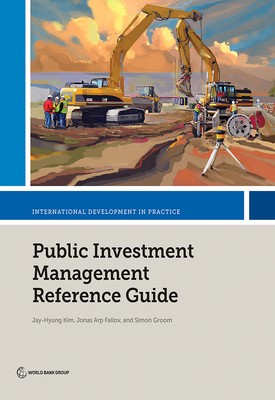
- We will send in 10–14 business days.
- Author: Jay-Hyung Kim
- Publisher: World Bank Publications
- Year: 2020
- Pages: 268
- ISBN-10: 1464815291
- ISBN-13: 9781464815294
- Format: 21.6 x 27.9 x 1.5 cm, minkšti viršeliai
- Language: English
- SAVE -10% with code: EXTRA
Reviews
Description
The Public Investment Management (PIM) Reference Guide aims to convey country experiences and good international practices as a basis for decisions on how to address a country-specific PIM reform agenda. The country references are drawn largely from previous diagnostics and technical assistance reports of the World Bank.
The application of country diagnostics and assessments has revealed a need to address the following issues when undertaking a country reform in PIM:
- Clarification of the definition and scope of public investment and public investment management
- Establishment of a sound legal, regulatory, and institutional setting for PIM, making sure it is linked to the budget process
- Allocation of roles and responsibilities for key players in PIM across government
- Strengthening of guidance on project preappraisal, appraisal, and selection-prioritization procedures and deepening of project appraisal methodologies
- Integration of strategic planning, project appraisal-selection, and capital budgeting
- Management of multiyear capital budget allocations and commitments
- Efforts to address effective implementation, procurement, and monitoring of projects
- Strengthening of asset management and ex post evaluation
- Integration of PIM and public-private partnership (PPP) in a unified framework
- Rationalization and prioritization of the existing PIM project portfolio
- Development of a PIM database and information technology in the form of a PIM information system.
The PIM Reference Guide does not seek to provide definitive answers or standard guidance for the common PIM issues facing countries. Nor does it seek to provide a detailed template for replication across countries: this would be impossible given the diversity of country situations. Instead, each chapter begins with an overview of the specific reform issue, lists approaches and experiences from different countries, and summarizes the references and good practices to be considered in designing country-specific reform actions.
EXTRA 10 % discount with code: EXTRA
The promotion ends in 21d.07:13:35
The discount code is valid when purchasing from 10 €. Discounts do not stack.
- Author: Jay-Hyung Kim
- Publisher: World Bank Publications
- Year: 2020
- Pages: 268
- ISBN-10: 1464815291
- ISBN-13: 9781464815294
- Format: 21.6 x 27.9 x 1.5 cm, minkšti viršeliai
- Language: English English
The Public Investment Management (PIM) Reference Guide aims to convey country experiences and good international practices as a basis for decisions on how to address a country-specific PIM reform agenda. The country references are drawn largely from previous diagnostics and technical assistance reports of the World Bank.
The application of country diagnostics and assessments has revealed a need to address the following issues when undertaking a country reform in PIM:
- Clarification of the definition and scope of public investment and public investment management
- Establishment of a sound legal, regulatory, and institutional setting for PIM, making sure it is linked to the budget process
- Allocation of roles and responsibilities for key players in PIM across government
- Strengthening of guidance on project preappraisal, appraisal, and selection-prioritization procedures and deepening of project appraisal methodologies
- Integration of strategic planning, project appraisal-selection, and capital budgeting
- Management of multiyear capital budget allocations and commitments
- Efforts to address effective implementation, procurement, and monitoring of projects
- Strengthening of asset management and ex post evaluation
- Integration of PIM and public-private partnership (PPP) in a unified framework
- Rationalization and prioritization of the existing PIM project portfolio
- Development of a PIM database and information technology in the form of a PIM information system.
The PIM Reference Guide does not seek to provide definitive answers or standard guidance for the common PIM issues facing countries. Nor does it seek to provide a detailed template for replication across countries: this would be impossible given the diversity of country situations. Instead, each chapter begins with an overview of the specific reform issue, lists approaches and experiences from different countries, and summarizes the references and good practices to be considered in designing country-specific reform actions.


Reviews